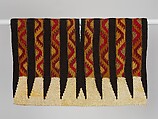Tunic
Not on view
Tunics, known as uncu in the language of the Incas (an ancestor of the present-day Quechua language), were the primary element of men’s attire in the Andes, and were worn over a simple loincloth. Tunics of this style have been found on the central coast of Peru but their technical features indicate that they are clearly a highland product. Contact between the highlands and the coast was common during the Inca empire, and this type of tunic probably dates from that time. Presumably, they originate from a highland area adjacent to the central coast. The construction of the tunic is peculiar, and its visual effect can be compared to that of the coastal imitations of this highland style. The exclusive use of camelid hair is another highland feature. Made of two loom pieces sewn together, the structure is a combination of discontinuous, dovetailed warps and discontinuous weft in the lower section and tapestry and weft-faced faced plain stripes in the upper section. The jagged patterns surely would have had to have been darned with a needle rather than woven. The fringe was created by twisting yarn bunches from the white section.
This image cannot be enlarged, viewed at full screen, or downloaded.

